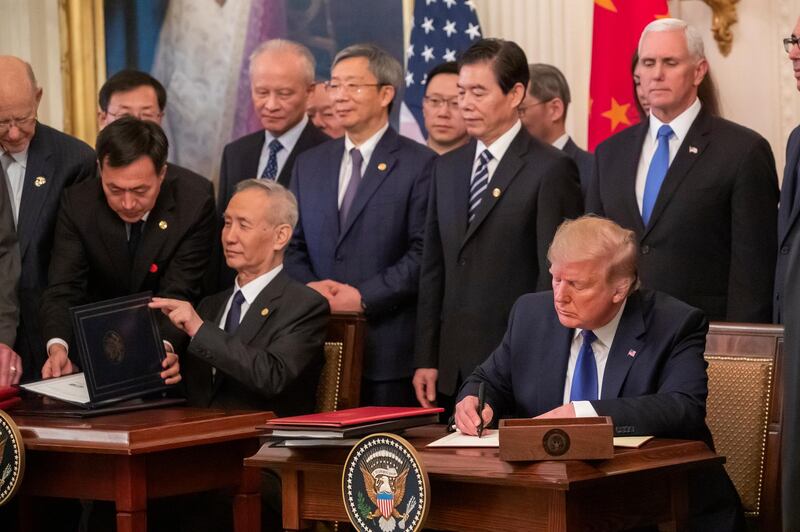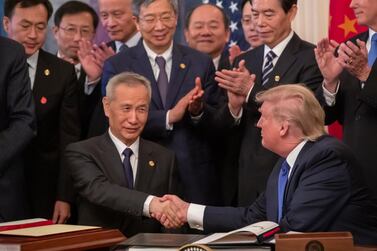Oil advanced as the US and China signed a phase one deal as the first step towards scaling back a two-year trade feud, which roiled the global economy and markets.
Brent rose 0.39 per cent at $64.25 per barrel at 2.16pm UAE time, while West Texas Intermediate advanced 0.09 per cent at $57.90 per barrel. Gold traded just above the $1550 an ounce mark.
Chinese President Xi Jinping, who was not present for the signing, said in a letter read by the country's top negotiator and vice premier Liu He, that the deal was "good for China, the US and the whole world".
Mr Trump said he would visit Beijing in "the not too distant future". He had previously indicated the two sides would hammer out a phase two deal this year.
"Together, we are righting the wrongs of the past," Mr Trump said at the signing.
As part of the phase one deal, China will increase its purchases of American crops and other exports, while providing protection for US technology as well as new enforcement mechanisms. Beijing will purchase $200bn worth of additional US goods, including $30bn worth of agricultural goods. The pact also calls on Beijing to open up to US financial services companies. However, tariffs on hundreds of billions of imports remain in place, with US consumers and industry likely to foot the bill. Also, questions over how China will rein in subsidies to state-backed companies also remain unaddressed.
"Investors are still optimistic that the deal prevents further escalation. But now it has been inked, questions are being raised about how much it really does for global growth," said Jasper Lawler, research head at London Capital Group.
Analysts also worry about a potential fallout if China doesn't fulfill its requirements under the pact.
"A potential failure could lead to renewed escalation in the trade relations between the two countries, which leaves the de-escalation in the trade conflict in a fragile state," said Sophie Altermatt, economic researcher at Julius Baer. "Further, the deal is limited and does not address some of the key issues between the countries, such as China’s industrial subsidies and cybertheft issues," she added.
Bethel Loh, macro strategist at ThinkMarkets said "even though phase two talks look to start 'very, very shortly', markets could be in for a bumpy ride if calls for non-compliance begin to get even louder."
The US-China trade war softened demand for crude and kept oil prices tepid for much of 2019, cushioning the markets against geopolitical shocks.
Oil prices largely contained their rallies following attacks on tankers along the congested Strait of Hormuz as well as a debilitating attack on Saudi Aramco's oil processing facilities in September, which wiped out 5 per cent of global supply temporarily.
Brent also spiked above $70 per barrel at the beginning of the year following heightened tensions between Washington and Tehran following the US' assassination of Iran's top military commander in Baghdad.
The death of Qassem Suleimani, who formerly headed the extraterritorial arm of the Islamic Revolutionary Guard Corps pushed the US and Iran close to military conflict, before both sides took measures to de-escalate.
"Middle East tensions pushed Brent above $70 per barrel in early January. From a fundamental standpoint, we believe that, unless larger production disruptions occur, Brent crude oil should trade in a range of $60–65 per barrel this year," said Giovanni Staunovo, commodity analyst with Swiss bank UBS.
Meanwhile, Opec revised upwards its oil demand growth for 2020 by 140,000 bpd on the prospect of higher economic growth in its latest monthly oil market report.
Supply growth from non-Opec sources is also likely to be higher, with Opec forecasting an increase of 180,000 bpd to 2.35 million bpd, led by increases in production in Norway, Mexico and Guyana.








